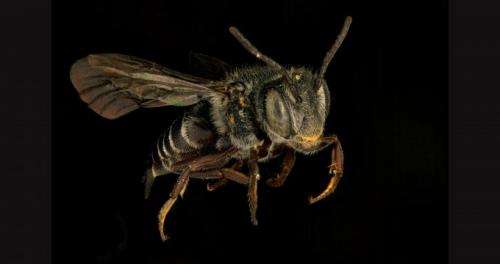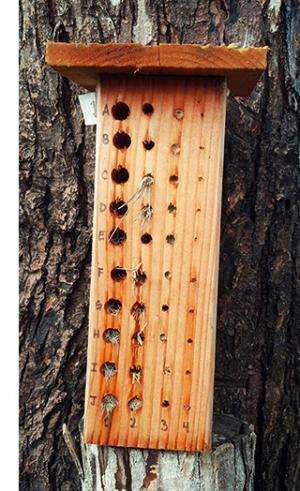Colorado's stunning bee diversity

For many people, the mention of bees brings to mind swarms, stings, queens and honey. But the insects fitting that description—non-native European honeybees—represent only one kind of bee.
In all Colorado is home to about 950 kinds of bees, the majority of which don't live in hives or other social groups. Some of the state's native bees aren't even yellow and black. One species is splashed in iridescent green; another is mostly black with a dark red rump. Some are plump and fuzzy, while others are slender and relatively smooth.
This summer, about 500 volunteers across the Front Range are getting the opportunity to have an up-close look at Colorado's stunning bee diversity as participants in The Bees' Needs, a citizen science project run by the University of Colorado Museum of Natural History.
"People don't know what bees are—and how could they unless they're taught?" said Virginia Scott, the "queen bee" behind the project and the Entomology Collection manager at the museum. "They're taught about honeybees, and they're taught about yellow jackets, which aren't even bees. About 70 percent of our bees in Colorado are solitary, meaning each female builds her own nest. They're like little birds."
The Bees' Needs—which doubled in size this year after the museum was overwhelmed with interest during the program's first year in 2013—is one of a handful of citizen science projects recently launched by the museum. The projects harness the enthusiasm of volunteers to help answer important scientific questions while also giving participants a hands-on educational opportunity.
"These projects allow us to expand the museum beyond the walls of this building—to bring the museum off campus, in a way," said Alexandra Rose, who leads the museum's citizen science efforts. "We have really important research going on here that affects everyone in Colorado. This is a way to engage people in what is happening here."
Bee houses
Along with The Bees' Needs, the museum recently launched two online citizen science projects. CondorWatch asks participants to look at photos taken of the massive, endangered birds by motion-activated cameras and record what the birds are eating. The data will be used by scientists to better understand which birds might be at greater risk of lead poisoning due to their diets.

Notes from Nature asks participants to transcribe the handwritten museum records pinned with individual museum specimens—including insects, birds, plants and fungi—so that scientists have a digital record of what species were found where and when. The resulting database will help researchers determine how biodiversity is changing across the globe and will make specimens, currently locked up in dark drawers and cabinets around the world, available at the click of a mouse.
The Bees' Needs involves having amateur bee lovers, mostly along the Front Range, put up "bee blocks" near their homes. Each block is drilled with 40 holes of varying sizes, creating an alluring place for solitary wood-nesting bees to lay their eggs.
"Normally, they nest in holes in dead wood. But people cut down dead trees, and they don't replace the bee habitat," Scott said. "Everybody puts up birdhouses, but nobody puts up bee houses."
The female bees that choose to use the blocks find a tunnel that's the right size, crawl into it, lay their eggs and then provision the nest with pollen. The bee then plugs the tunnel with nesting material. Some bees cut bits of leaves and drag them back to their nests to make the plugs. Others haul up blades of grass, mud, pinesap or even pebbles.
The citizen scientists record when the plug appears and what it's made of. From that information, Scott—who has been studying bees since the early 1980s—can determine what kind of bees live in the blocks.
"There's an element of magic," Rose said. "The blocks don't attract these bees—they're already there—but you never see them. You put up this block, and these plugs appear and you know there are baby bees in there. If you're patient or if you're lucky, you may even get to see them."
Hinting at new discoveries
The project meets multiple goals for the museum. First, it simply makes more habitat available for bees to use. Second, it allows people to learn about the bees and get a glimpse of the diversity of insects that already live in the neighborhood. But also, the data collected by the participants may give Scott and other entomologists new insight into where the bees live, what kinds of conditions they prefer and how common they are.
With only one year of data in the books, it's too early to make many statements about new things the researchers have learned with the help of the citizen scientists. But even so, there were a few tantalizing discoveries from the first year that invite more study.
For example, it looks like the presence of honeybee hives near the bee block doesn't affect the solitary bees nesting in the blocks—but the presence of birdfeeders might. Bee blocks put up near bird feeders tended not to have any bees using the smallest tunnels, which begs the question of whether the birds might prey on the tiniest wild bees.
The scientists also were interested to find that some participants didn't get any bees—thought it's not clear if there were no bees around or if the bees had other, more appealing nesting options at those sites—and other participants had non-native bees nesting in their blocks at higher elevations than they had previously been found.
But even if no major scientific findings come from The Bees' Needs, the museum staff would be happy if the participants came away with a new appreciation of how fascinating bees can be, just like Scott did when she took her first field entomology class in college and was introduced to leaf-cutting bees.
"I was hooked," she said. "They're so sweet. I call them flying teddy bears."
Provided by University of Colorado at Boulder



















